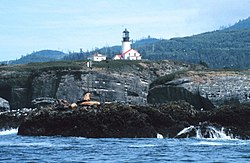Tatoosh Island, Washington

The island from the air.
|
|
| Geography | |
|---|---|
| Location | Makah Reservation, Clallam County, Washington, United States |
| Coordinates | 48°23′31″N 124°44′06″W / 48.392°N 124.735°WCoordinates: 48°23′31″N 124°44′06″W / 48.392°N 124.735°W |
| Administration | |
| State | Washington |
| County | Clallam County |
|
Tatoosh Island
|
|

Cape Flattery Light from offshore
|
|
| Location | Olympic Peninsula, Washington |
|---|---|
| Built | 1857 |
| Architect | US Coast Guard |
| NRHP Reference # | 72001267 |
| Added to NRHP | March 16, 1972 |
Tatoosh Island is a small island and small group of islands about 0.5 miles (0.8 km) offshore (northwest) of Cape Flattery, which is on the northwestern tip of the Olympic Peninsula in Washington. Tatoosh is the largest of a small group of islands also often referred to as simply "Tatoosh Island", which are almost as far west as Cape Alava, about 15 miles (24 km) to the south and the westernmost point in the contiguous 48 states. The islands are part of the Makah Reservation and a part of Clallam County. The total land area of the island group is 159,807 square metres (1,720,150 square feet).
Historically, Tatoosh Island was inhabited seasonally by Makah fishing camps and employees of the United States Coast Guard, Weather Bureau, and Navy. Currently there is no resident population on the islands. Access to the island requires written permission of the Makah tribe. The island's name comes from a Makah chief known as Tatoosh (also Tatooche or Tetacus).
Tatoosh Island has been home to Cape Flattery Light, which overlooks the entrance to the Strait of Juan de Fuca, since December 28, 1857.
Because of its isolation, climate, and location in the ecologically productive northeastern Pacific Ocean, Tatoosh Island is home to many nesting seabirds, several marine mammals, and a diverse community of marine plants and animals. Beginning in 1967, Professor Robert T. Paine of the University of Washington and his colleagues have undertaken detailed studies of marine ecology on the island. Consequently, it is now one of the most intensively studied field sites in the world.
The research has revealed how species are linked to each other through a network of species interactions, and how environmental changes and species extinction are transmitted through the food web. Key ecological concepts explored by this research include keystone species, control by consumers and natural disturbances on ecosystem structure and spatial patterning, species interaction strength, body size-dependent population dynamics, and impacts of environmental changes such as ocean acidification and El Niño events on complex ecosystems.
...
Wikipedia
